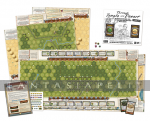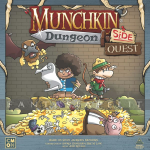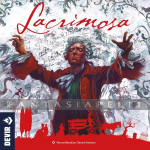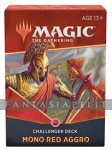Tuotehaku
Ruutunäkymän liikennevaloissa vihreä on heti saatavilla, punainen juuri nyt loppu varastosta, keltainen ei vielä ilmestynyt tai huutomerkin kera ei hyllyvalikoimaa, eli me tilaamme sitten, kun sinä olet tilannut meiltä. Saatavuusinfossa kerrotaan tarkemmin saatavuustiedoista.
Haun tulokset 49 - 72 / 100

Humanity is in danger of extinction...and it all started in a small Spanish village. In every corner of the world, the mystery behind the mass fatalities remains at the forefront of everyone's mind. In the latest volume, a strange man claims to know the origin behind humanity's demise. Who is this man, and how will he change the fate of the world?!
SC, 384pgs, B&W

Draft Boosters are for Limited formats, like Booster Draft and Sealed Deck. They're the classic Magic booster pack—15 cards from the set designed for a balanced Draft experience, plus an ad card or token.
Contents:
36 Zendikar Rising Draft Booster packs


You can also choose to change up the terrain type and fight the very first tank battle between the US and Germany on the sands of North Africa, clashing in the middle of the desert.
This expansion requires at least one copy of Memoir ’44 as well as the Pacific Theatre and Mediterranean Theater expansions to play.

Warhammer 40k 9th edition playmat - Grass 44x30". Material: neoprene.
- Is flat when unfolded
- 2 mm thick
- Resistant to folding
- A non-slip surface
- Suppresses the sound of dice
- Material satin / rubber
- Washable
Paketin koosta johtuen, ei toimitusta pakettiautomaattiin.

Just wook at da widdle evil beasties! SO CUTE!!
Sure, they’re going to munch your face off, but they’re JUST SO ADORABLE!! Who could possibly complain when CuteZilla roasts them alive? It would take an outright psychopath bent on nothing but slaughter and Loot to even think about raising a blade against these PRETTY LITTLE HORRORS!! Hey... doesn’t “psychopaths bent on slaughter and Loot” describe most adventuring parties?
Contains:
* 5 Miniatures
* 1 Who Wants to be the Cutest board
* 24 Threat cards
* 12 Room cards
* 24 Loot cards

Sub-Quest for the dungeon.
When you play with this expansion, a number of Side Quest gets opened. To complete them you'll have to do some nice things like "Be defeated" or "Defeat a Roaming Monster without using rerolls (ha!)."
But Why?
You wouldn't normally go out of your way to fulfill these annoying quests, right? Here's the catch: as you complete them, you gain Levels! Keep in mind they're open information so other Heroes may have their eyes on them, too!

The Munchkin Dice Bag is an awesome item with an awesome munchkinly bonus. When the players fill it with official Munchkin six-sided dice, the bag’s special rule will let them turn failure into success.
And it comes with two new Munchkin cards, Blind Chance and Bag of Hoarding, that give it extra one-time powers!
Description: Zippered dice bag and two cards.
• It’s got the rule printed right on it!
• . . . and it’s a good rule that works with the munchkin-head dice you get in the games . . .
• and the two bonus cards give awesome one-shot powers!

Agatha Heterodyne and all her friends, and enemies, invade your gaming table in Munchkin Steampunk: Girl Genius, an expansion for Munchkin Steampunk based on the hit webcomic from Studio Foglio.
Designed by Steve Jackson and illustrated by Girl Genius creator Phil Foglio, this expansion includes new foes, new Treasures, and the fan-favorite Sparks... including new Spark tokens and rules for using them!
112 cards and 20 tokens in a tuckbox.
Designed by Steve Jackson
Illustrated by Phil Foglio

Neovillen rakennusprojekti on mitä erikoisin. Rakenna kaupunki joka mukautuu täysin luonnon keskelle ja rakentuu sen ehdoilla. Haastavaa, mutta juuri sellainen homma jota olet kaivannutkin!
Tavoitteesi on selkeä. Rakenna kaupunkisi tiukkien rajoitusten mukaisesti ja varmista että kovassa kilpailussa vain sinä ja sinun kaupunkisi nousee otsikoihin!
Sisältö:
78 laattaa
28 pilvenpiirtäjää
36 palvelumerkkiä
säännöt
Pelaajia: 2-4
Kesto: 30-45 min
Ikä: 10+

Kaksi Hugo Prattin Korkkari-tarinaa!
In Night of the Devil, take a hallucinatory trip through the oppressive heat of the Burmese jungle along with British soldiers engaged in desperate skirmishes with the enemy. In Bayonet Jungle, Private Jack Green's presence is seen as an omen of bad luck but he struggles to prove himself to the experienced soldiers of Third Platoon as they fight against the Japanese army that surrounds them.
Two exciting and explosive war stories lushly illustrated by Hugo Pratt, comics' legend and creator of iconic character, Corto Maltese.
144pgs, B&W

A decade ago, 300,000 citizens of Philadelphia were suddenly lost in Oblivion. There was a time when Nathan Cole was the only one searching Oblivion for human survivors lost there.
Now, he's the one in need of rescue!
Collects OBLIVION SONG #25-30.
SC, 144pgs, FC

Yue, he is startled and blurts out the name "Yoshiki." What exactly is the connection between this Yoshiki, to whom it seems Tougo owes his life, and Yue? And what kind of relationship existed between Yoshiki and Tougo's mother? The secret behind the meal is at long last revealed!
SC, 160pgs, B&W

Pictures is a quick-playing family game with very simple rules. Form the image on your secret picture card with one set of components, either shoelaces, color cubes, icon cards, sticks and stones or building blocks in such a way that the other players guess what image you have pictured:
Pull out a marker from the bag that determines your secret picture card.
Then form that image with your components in such a way that it is recognizable.
And finally guess what image each other player has pictured.
Bilingual: english, german
3–5 Players
20–30 Min
Age: 8+

Sun dreams of money. Moon dreams of scientific discoveries. When their paths cross with Team Skull, both their plans go awry... International Police officers Looker and Anabel arrive on the scene and hire Sun to help them pursue the mysterious Ultra Beasts-and not a moment too soon, because the Ultra Beasts are attacking one island after another in the Alola region. And then, a group of Crabrawler steals Sun's special berry!
What is the shocking secret of Anabel's origin?
SC, 5x7, 88pgs, B&W

From Harry Potter, Harry, as a stylized Mini Moments from Funko!
This Mini Moment is perfect for any fan of Harry Potter!

From Harry Potter, Harry, as a stylized Mini Moments from Funko!
This Mini Moment is perfect for any fan of Harry Potter!

Ghoul Island is the first 5e campaign adventure for Sandy Petersens Cthulhu Mythos and can be easily introduced into any fantasy setting.
This first act (of four), Voyage to Farzeen, begins with a mutiny and ends in underground tunnels where our adventurers discover an ancient temple dedicated to a horror thought to have been vanquished long ago!
Uutuuksia
|
LIIKKEET
|
TILAAMISESTA |
|
INFO |
















